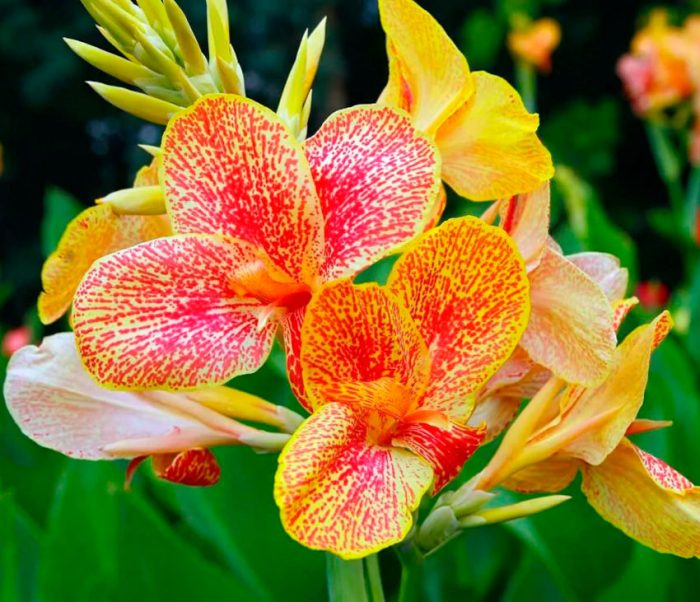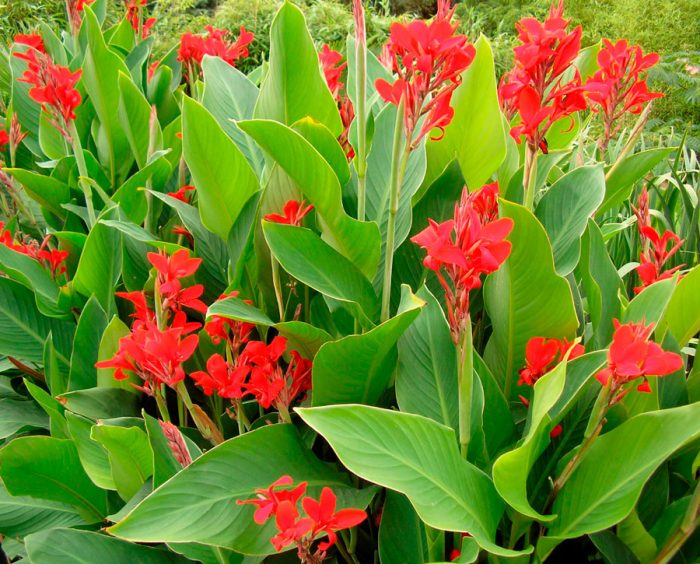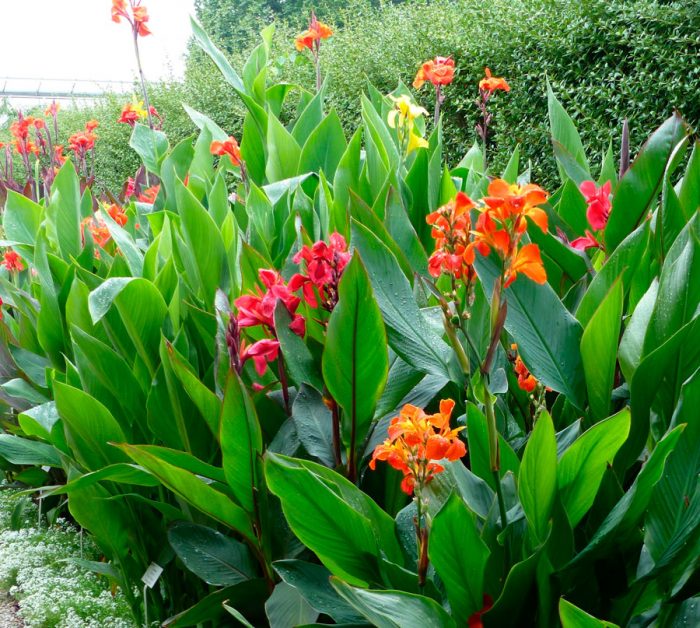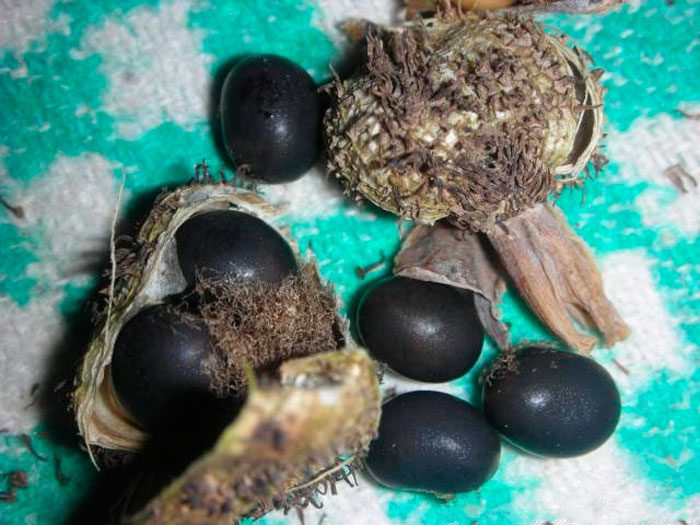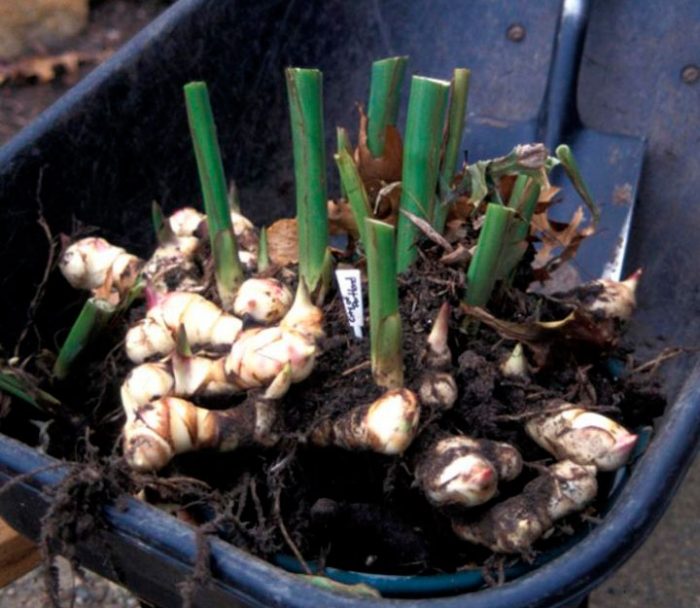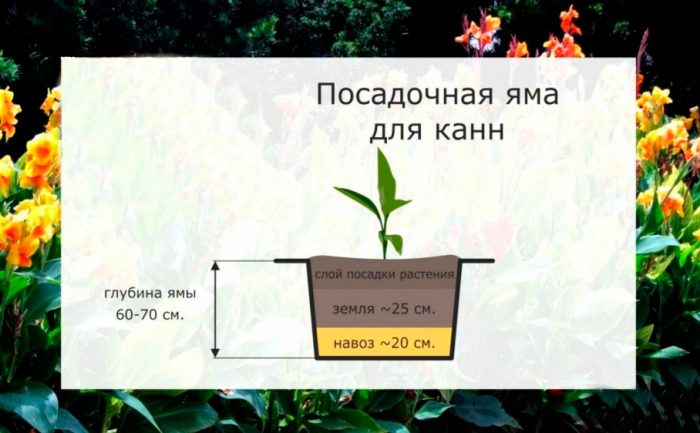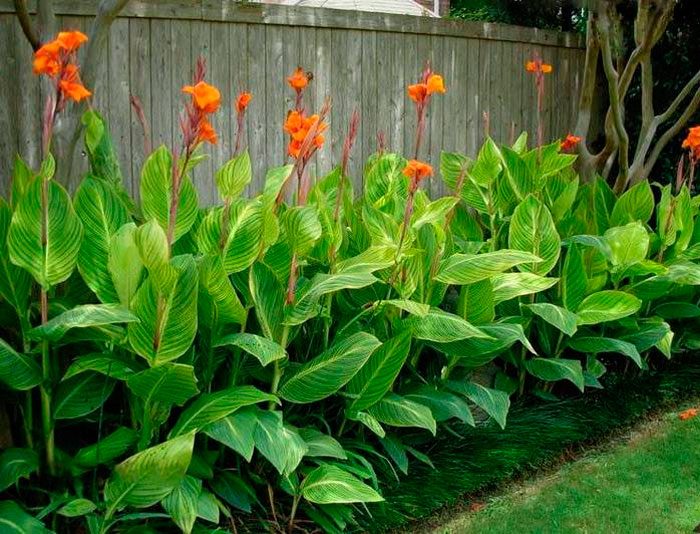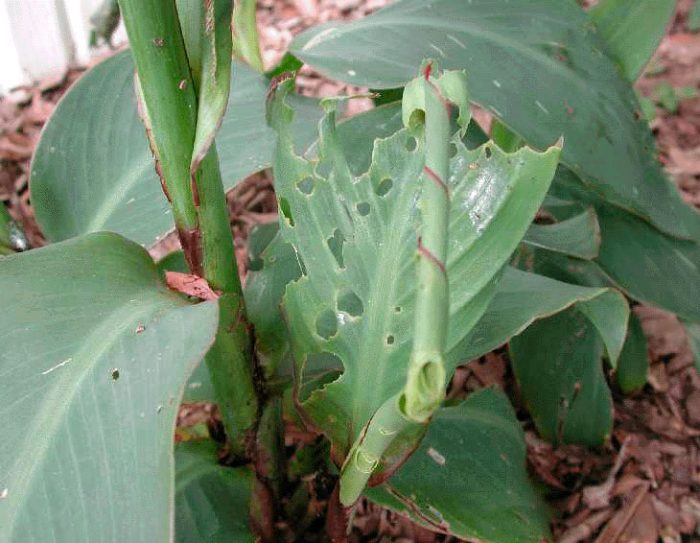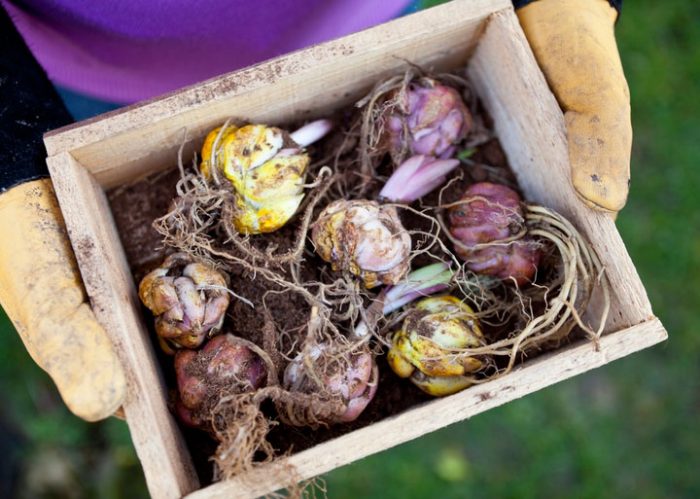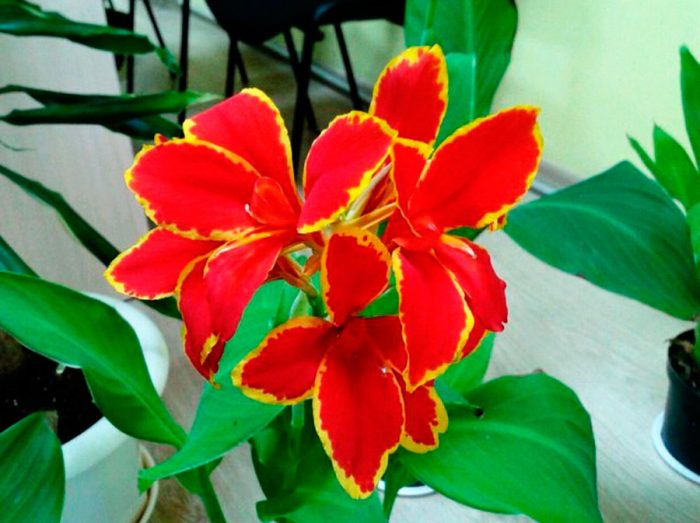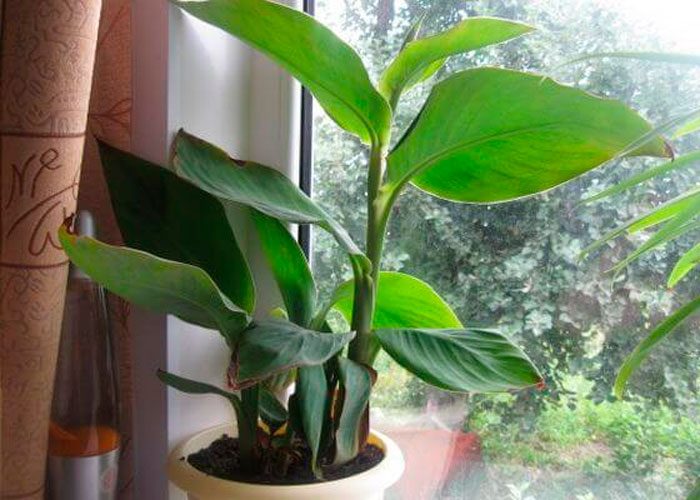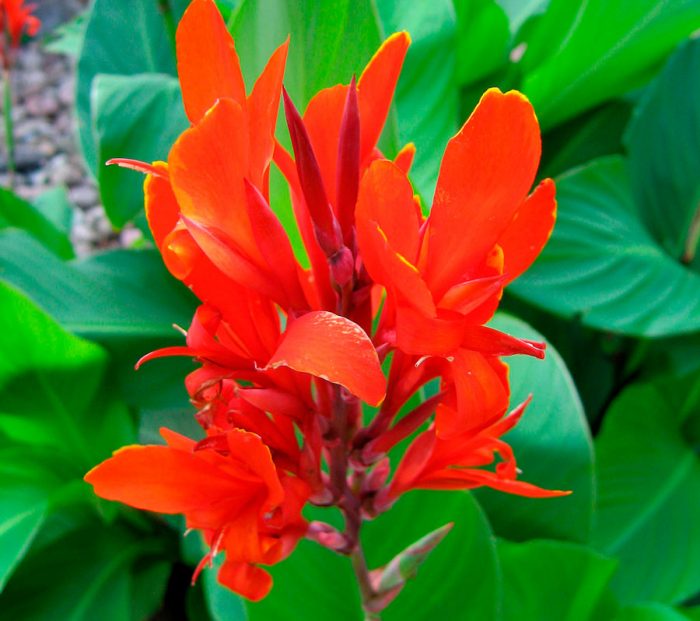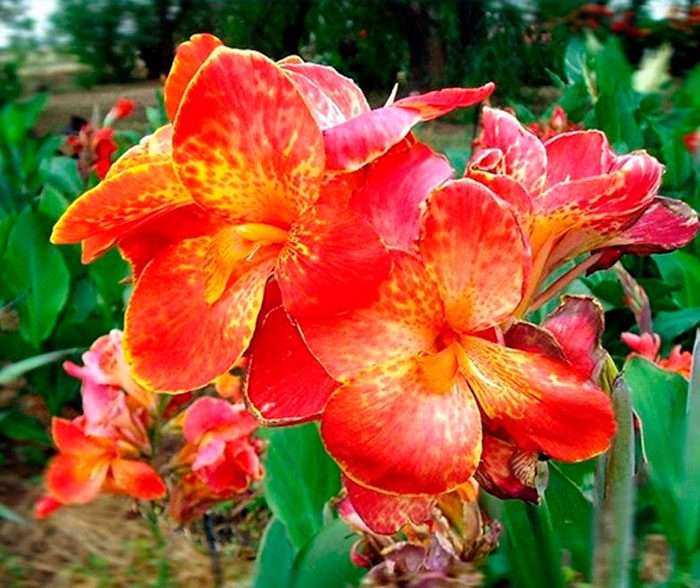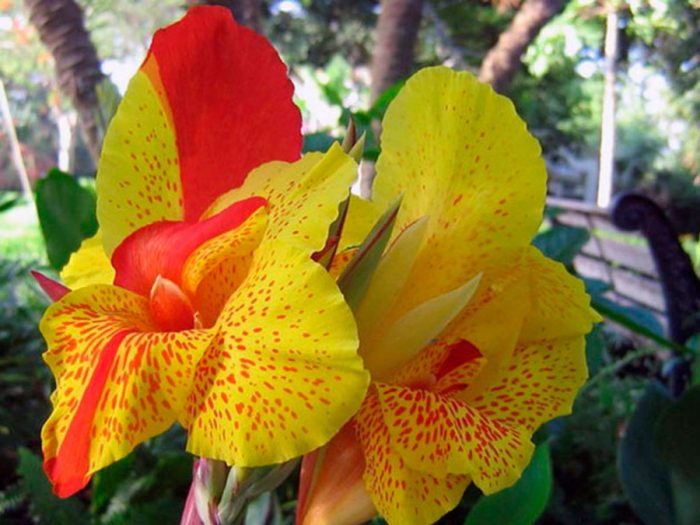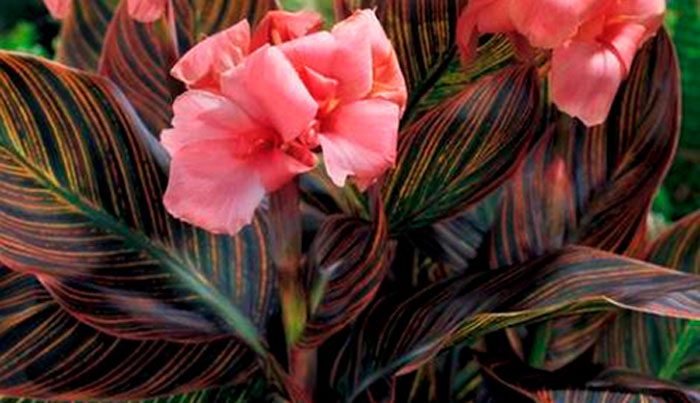The monotypic genus Canna belongs to the Cannaceae family of the order Gingerbread, which includes about 50 species of herbaceous plants. In natural conditions, such a flower can be found in South and Central America, China and India. Cannes came to Europe thanks to Portuguese sailors only in the 16th century, but they began to grow only in the 17th century. From the Greek language "canna" is translated as "reed". The fact is that the stem of such a flower is very similar to a reed. The name of this flower is translated from Latin as "pipe". There is a very old legend, which says that the canna flower first grew on the place where there was a fire, in which a wampum with a peace treaty rolled into a tube was burned by an Indian chief. As a result, a bloody war began, and the blood-red flowers of the canna symbolize the blood that was shed in this war or the flames of that very fire. This plant is valued for the fact that it blooms effectively, and also has large beautiful leaf plates that can be painted in dark purple, violet, dark green or bronze red.
Content
Brief description of cultivation
- Landing... Seeds are sown for seedlings in February, tubers are planted in mid-May, and sprouted tubers are planted from the first days of March.
- Bloom... It begins in July and continues until the frost.
- Illumination. Needs a lot of light.
- Priming... The soil should be nutritious, rich in organic matter, well-drained and warm.
- Watering... Water should be watered moderately but systematically. However, it should be abundant during the flowering period.
- Fertilizer... You need to feed it twice or three times during the season; for this, mineral fertilizers are used.
- Reproduction... Seed method and dividing the rhizome.
- Harmful insects... Nematodes, butterfly caterpillars, scale insects, spider mites, aphids, slugs.
- Diseases... Rust, gray rot, variegation, cucumber mosaic virus.
Cannes features
Externally, the canna bush is similar to a hybrid of an orchid or gladiolus and a banana. Such a plant has a couple of disadvantages, namely: when grown in mid-latitudes, its flowers do not have a scent, and it can also freeze out in too cold winter. Otherwise, this plant is completely satisfied with gardeners.
Canna is highly resistant to disease, so even an inexperienced gardener can cultivate it. This plant is very impressive and is distinguished by its unpretentiousness and drought resistance. It blooms for a very long time from the last days of June until the first frost. The branching rhizome of the canna grows in breadth. Erect flowering stems are high (60–300 cm) and thick. Powerful large leaf plates are pointed, their shape is elliptical or oblong, their length can vary from 0.25 to 0.8 m, and width - from 0.1 to 0.3 m. Due to the color and shape of the foliage, the plant looks very impressive. But it looks most decorative after its incredibly beautiful flowers open. Bisexual sharply asymmetric flowers have a size of 40 to 80 mm, they have a red color. As a result of breeding work, varieties with flowers of pink, yellow and orange appeared, there are also bordered, bicolored and speckled varieties. The rarest are cannes with white flowers. Flowers are part of racemose or paniculate inflorescences. The fruit is a three-nested capsule.
Growing cannes in the garden
Sowing seeds
When sowing canna seeds, it should be borne in mind that the seedlings that have appeared are often not able to preserve the varietal characteristics of the parent plant. And you also need to remember that not all varieties are capable of setting seeds. In this regard, the most popular among gardeners is the vegetative method of reproduction - by dividing the rhizome.
However, if there is a great desire, then it is quite possible to grow such a flower from seeds. Its seeds are covered with an extremely strong and dense shell, which must be softened before sowing. To begin with, the seed must be doused with freshly boiled water, and then it is put into a thermos, into which lukewarm water is poured, there it should stay from 3 to 4 hours. Instead, it can be put on a hot battery for 12 hours. Also, instead of seeds, you can freeze, for this they are placed in the refrigerator for 1–2 hours.
Sowing seeds should be carried out in February, while using a light substrate, the air temperature should be from 22 to 23 degrees, the crops require partial shade. The first seedlings should appear after 20-30 days, their picking into individual pots should be carried out after the formation of 3 or 4 real leaf plates. Before transplanting into open soil, seedlings should be kept in a cool place (about 16 degrees). Some of the seedlings are able to bloom already in the current season, and in the other part, flowers will form only next year.
Growing tubers
A more reliable method of reproduction, which will allow you to get bushes that bloom in the summer, is the method of dividing the tubers. In the first days of March, divide the tuber into parts, while on each of the divisions there should be several weak buds or one large one. Places of cuts must be treated with coal powder and dried. Put the delenki in a greenhouse container very tightly to each other, they must be placed on the surface of the sand or soil, while the buds must be placed horizontally. On top of the delenki it is necessary to fill it with a layer of sand, which must be periodically moistened with lukewarm water from a spray bottle. It is best to germinate the buds at an air temperature of 20 to 24 degrees, for this, experts advise to slightly warm the container from below. After the foliage appears and it becomes cramped for them, they will need to be planted in individual small pots, which are removed in a well-lit and cool place (about 16 degrees). There they will stay there before transplanting into open soil, during which time they will have time to get stronger, once every 10 days, the bushes must be watered with a solution of potassium permanganate (for 1 bucket of water 2 grams). Some gardeners prefer not to grow cannes tubers, as a result of which flowering begins much later, and in some cases the bushes do not bloom at all.
When to plant cannes
After the spring return frosts are left behind, you can begin to prepare the site for planting. Such a flower prefers well-lit areas that have reliable protection from drafts. The soil should be organic, nutritious and warm. Canna needs exactly the same growing conditions and care as a cucumber. A soil mixture consisting of leafy earth, peat, humus and coarse sand (1: 1: 1: 1) is perfect for growing it. Make a good drainage layer at the bottom of the holes.
Experts recommend planting such a flower in open soil no earlier than May 9, the fact is that if in spring the bushes are exposed to sudden changes in temperature, then their growth will slow down, and they will bloom much later or will not bloom at all.


Watch this video on YouTube
Landing
Cannes should be planted from the middle to the end of May, but only after the frosts are definitely left behind. In order for the bushes to grow and develop very well, they will need to make a "hot" litter. To begin with, make a planting hole in diameter reaching 0.5-0.6 m, and at its bottom make a good drainage layer of fresh manure, the thickness of which should be about 20 cm. Thanks to manure, the root system of flowers will always be warm, which will cause active growth and lush flowering of bushes. Manure must be covered with soil, while the thickness of the layer should be about 25 cm. After the soil is abundantly watered, bushes are planted into it, which are then added dropwise. When planting a non-sprouted bulb, it should be sealed to a depth of no more than 60–90 mm. The distance between the bushes and the row spacing should be about 50 cm. After planting in the soil, it will take only 6-8 weeks and the bushes will bloom.
Canal care in the garden
Top dressing
During the growing season, cannes should be fed twice or thrice; for this, mineral fertilizers are used. When the bushes are watered, fertilizer in granules should be poured onto the soil surface near them, after which the soil is loosened. For 1 square meter of the plot, from 40 to 50 grams of a nutrient mixture is taken, consisting of 12 grams of nitrogen, 10 grams of potash and 25 grams of phosphorus fertilizer.
Watering
Watering the bushes should be systematic and moderate until the stems appear. After the beginning of flowering, you need to increase the abundance of watering, but you should not allow stagnation of liquid in the root system. If waterlogging occurs regularly, this will lead to the development of a bacterial or fungal disease, as a result of which the buds turn black and die off.
Pests
In addition to the diseases described above, nematodes can harm the root system of the cannes, and the caterpillars of butterflies can harm the foliage. To get rid of such pests, the bushes need to be sprayed with insecticidal preparations.
Growing
Inflorescences that have already faded must be removed. From the beginning to the middle of the growing season, weeds must be removed in a timely manner. When the bushes have bloomed and before the first frost, they must be hilled high, in this case, you can protect the root collars from frost damage. When the cannes growing in the garden have finished blooming, they need to be watered less and less until the watering stops at all.
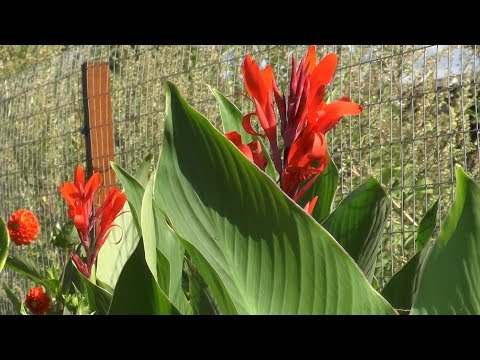

Watch this video on YouTube
Preparing for winter
Before the frost begins, the bushes should be huddled high, which will help protect the root collars from severe frosts, if this is not done, then rot may appear on them during storage in winter. As soon as the first frosts pass, the shoots from the bushes are cut off at a height of 15 to 20 centimeters, and then the rhizome is dug out together with an earthen lump. Then the bushes are removed to the place where they will be until the onset of spring. A cool place with diffused light and moderate humidity is perfect for this.
Rhizomes must be placed in wooden boxes, while they are sprinkled with a mixture of sand, peat, soil and sawdust of non-coniferous trees. It is best if the moisture content of the mixture is about 50%, while the temperature should be from 6 to 8 degrees. During the storage period, systematically examine the rhizomes, and as soon as rot appears on them, the affected area is cut out to healthy tissue, while the sections should be treated with iodine. You should also try to maintain the recommended humidity level and temperature, avoiding sudden temperature changes.
If desired, the rhizomes can be placed on the refrigerator shelf until spring. To do this, the rhizomes extracted in autumn must be thoroughly washed using running water, then they are placed in a solution of potassium manganese for 24 hours, after which they are dried and each tuber is individually wrapped in a paper sheet. Then they are placed in the refrigerator on the vegetable shelf, while in winter they must be systematically examined for rot.
Also, dry rhizomes can be folded into a plastic bucket, they are covered with a layer of dry soil and stored on the balcony. During severe frosts, a container with tubers is brought into the house and placed on the floor near the balcony door.
Also, tubers are perfectly stored in a container in the soil in a cool room (no more than 15 degrees). The container can be placed in the attic, loggia or veranda. Water the ground once every 2 weeks with a little water.
In regions with mild warm winters, rhizomes are stored directly in the garden. They are dug up and stacked on a site that is not flooded by melt water in spring, and also has reliable protection from the wind. From above, they should be covered with dry sawdust, while the layer should be about 20 cm.


Watch this video on YouTube
Canna at home
Flower growers widely cultivate cannu as a tub or pot plant. For this, those varieties and types are suitable that can fit on a terrace, in a room or on a balcony. Indoor cannes are highly decorative plants, so they can become the center of the flower arrangement of every winter garden. Plus, the dormant period for such a plant grown in indoor conditions is only 8 weeks, while the rest of the time it looks very impressive thanks to its beautiful foliage and beautiful flowers.
Like any other indoor flowers, cannu can be constantly grown at home using an ordinary flower pot. Or, in the autumn, you can dig a bush growing in the open field and plant it in a pot or tub, reaching half a meter in diameter. Do not forget to spill the garden soil with an insecticidal solution before planting a flower, which will reduce the possibility of damage to the plant by various pests.
Basic rules of care
It is much easier to care for a room canal than for the one that grows in the garden, the fact is that in this case it does not need spraying, weeding, feeding and loosening the surface of the substrate. For a flower, you need to choose a sunny place, and well-settled water is used for watering it, and the procedure itself is carried out only when necessary. It is also necessary to periodically remove dust from the surface of the foliage using a damp soft cloth. When the flowering is over, the bush will still look very impressive thanks to its unusual leaves.
After flowering
A faded bush, as a rule, needs to rest, so it is necessary to start to reduce watering and eventually stop it altogether for a while, but this should be done gradually. The foliage should be cut at a height of 10 to 15 centimeters from the base of the bush. Then the flower is transferred to a dry place, where it should be cool enough (at least 10 degrees). In spring, the rhizome must be removed from the pot, after which it is divided into several parts and seated. The resulting cuttings can be grown on the balcony, at home or in the open field.


Watch this video on YouTube
Cannes varieties with photos and names
Indian Canna (Canna indica)
Almost all types of cannes, which are currently popular with gardeners, were born thanks to the Indian canna. Cultivated varieties of such cannes are called garden cannabis. These hybrids are divided into 3 groups by gardeners:
Cannes Crosey
These are undersized species, the height of which varies from 0.6 to 1.6 m. Their flowers are outwardly similar to gladioli. On the surface of bronze-purple or dark green leaf plates, there is a bloom of white. Flowers have bent petals. In 1868, the first hybrid was created by the French breeder Crozi, later this garden canna became known as the French canna or canna Crozi. The most popular varieties of such cannes are:
- Livadia - on the bushes of one meter height, inflorescences of crimson-red color grow, the length of which is from 25 to 30 centimeters, the foliage is purple, flowering begins in July;
- America - the height of the bushes is from 1.2 to 1.4 m, the flowers are cinnabar-red, reaching 12 centimeters across, the inflorescences are from 0.3 to 0.35 m long, the foliage color is purple, flowering begins in July;
- The president - the height of the bushes is about 100 cm, the length of the inflorescences, consisting of rich red flowers, about 0.3 m, the foliage is green, flowering begins in July.
Orchid cannes
The flowers of this plant are similar in shape to Cattleya. The height of this vigorous plant is from 100 to 200 cm, the flowers are large (from 12.5 to 17.5 centimeters), the edge of the petals is corrugated. The color of the foliage is green-purple or green. The most popular varieties are:
- Andenken an Pfitzer - the height of the bushes is from 1.1 to 1.4 m, the length of the inflorescences is about 0.3 m, they consist of flowers of a rich orange color with red streaks, the foliage is purple-brown, flowering is observed in July;
- Suevia - the bushes reach a height of about 100 cm, the size of the inflorescences is 12x15 cm, they consist of lemon-colored flowers, the foliage is green, flowering begins in the last days of June;
- Richard Wallace - the height of the plant is about 100 cm, the length of the inflorescences is from 20 to 23 centimeters, they include yellowish flowers, on the surface of which there are red specks, the foliage is green, flowering begins in June.
Small-flowered (deciduous) cannes
The bush reaches a height of about 300 cm, it is decorated with very spectacular leaf plates of purple, green or green-purple color. However, such a plant has very small flowers, no more than 60 mm in size, it is extremely rarely cultivated. The most popular variety is Durban: the color of the flowers is orange-yellow, the striped leaf plates are very decorative, their color is bronze-green-pink-yellow.


Watch this video on YouTube

